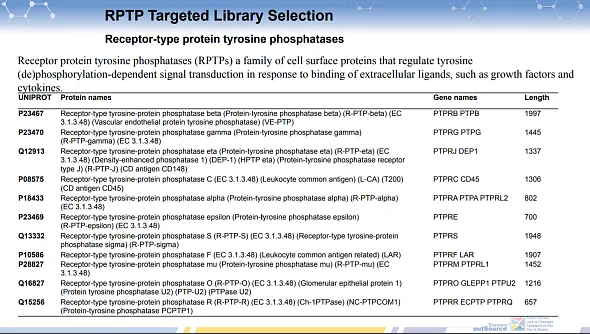Receptor protein tyrosine phosphatases
ChemDiv’s library of small molecule compounds targeting receptor-type protein tyrosine phosphatases comprises 3,900 entries.
Protein tyrosine phosphorylation is a critical regulatory mechanism that regulates cell proliferation, differentiation, communication, and adhesion. Disruptions in this key regulatory process contribute to various human diseases, including cancer, diabetes, and autoimmune diseases. Net protein tyrosine phosphorylation is determined by the dynamic equilibrium between the activities of protein tyrosine kinases (PTKs) and protein tyrosine phosphatases (PTPs). Mammals express a wide array of distinct PTKs and PTPs, both of which are further subdivided into non-receptor and receptor subtypes. Receptor-type protein tyrosine phosphatases (RPTPs) serve as enzymatic and functional counterparts to receptor protein tyrosine kinases (RPTKs). RPTPs are a family of integral cell surface proteins featuring intracellular PTP activity. Their extracellular domains exhibit sequence homology to cell adhesion molecules and are capable of binding to extracellular ligands, such as growth factors and cytokines [1].
RPTPs play a significant role in drug discovery and therapy due to their involvement in key cellular processes such as growth factor signaling, cell differentiation, and immune response regulation. They present a dual opportunity in therapeutic targeting - not only can they regulate intracellular phosphorylation events, but their extracellular domains also allow for potential modulation of cell-cell interactions and ligand binding. This makes RPTPs attractive targets for a variety of diseases, including cancer, where dysregulation of tyrosine phosphorylation is a common hallmark, as well as autoimmune and metabolic disorders. Targeting RPTPs offers a novel approach to modulating these signaling pathways, providing opportunities for the development of new therapies that can more precisely influence disease progression at multiple levels, from extracellular interactions to intracellular signaling cascades.
RPTPs, situated on the cell surface, possess both extracellular domains that interact with various ligands, such as growth factors and cytokines, and intracellular phosphatase domains that dephosphorylate specific tyrosine residues on proteins. By engaging with RPTPs, drugs can either inhibit or enhance their phosphatase activity, leading to alterations in downstream signaling pathways that control essential cellular processes like proliferation, differentiation, and immune responses. This modulation can result in therapeutic effects, such as inhibiting the proliferation of cancer cells by disrupting aberrant signaling pathways or regulating immune responses in autoimmune diseases. Thus, drugs acting on RPTPs have the potential to offer targeted therapeutic interventions by precisely influencing key signaling mechanisms at the cellular level. The complexity and diversity of RPTPs also mean that they could be used to develop highly specific drugs with potentially fewer side effects compared to broader-acting agents.
The development of drugs targeting RPTPs presents certain challenges, such as achieving specificity and avoiding off-target effects, given the critical roles these enzymes play in numerous physiological processes. Additionally, designing small molecules that effectively modulate the activity of these large, membrane-bound proteins is complex. Despite these challenges, the interest in RPTPs as drug targets remains high due to their involvement in key signaling pathways and their potential to provide new therapeutic options for diseases with unmet medical needs.
References
[1] Y. Xu and G. J. Fisher, “Receptor type protein tyrosine phosphatases (RPTPs) – Roles in signal transduction and human disease,” J. Cell Commun. Signal., vol. 6, no. 3, pp. 125–138, 2012, doi: 10.1007/s12079-012-0171-5.
